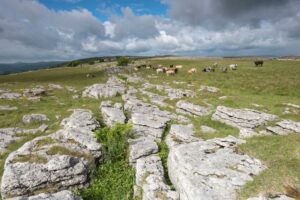Support us from £3/month
We deal with almost 1000 cases a year assisting communities, groups and individuals in protecting their local spaces and paths in all parts of England and Wales. Can you help us by joining as a member?
Open Spaces Society case officer Hugh Craddock and Friends of the Lake District planning officer Lorayne Wall MRTPI, on 7 June addressed members of the Royal Town Planning Institute on planning for commons.
At the Institute’s rural update for north of England, members heard about ‘Planning and Common Land’, raising awareness of how and why commons and town or village greens are relevant in the planning process and what can be done to reduce conflict and misunderstanding between the needs of planners, developers, and the protection of commons and greens.

Conservation grazing on Little Asby Common, Westmorland Dales, Cumbria. Photo: Friends of the Lake District.
Hugh and Lorayne explained why commons and greens are so important today—for farming, recreation and nature conservation. Lorayne described how common land is an attribute of the designation of the Lake District as a World Heritage Site, and must be taken into account in determining applications affecting it.
Hugh and Lorayne called for wider use of ‘informatives’: notes added to planning permissions, drawing the applicant’s attention to the need for a further consent from the Secretary of State in relation to common land. And they took members through a selection of recent development projects in the north of England which had been delayed or derailed owing to misunderstandings about commons and greens.
Hugh said: ‘Too often, those applying for planning permission are unaware of the special nature of common land and of the constraints on its development. Planning consultants and planning officers can do much to help resolve the difficulties which can arise, and are often the first point of professional contact. Today’s presentation is designed to raise understanding of the position of commons and greens in development, and how the planning system can head off conflict and reduce delays.’
Lorayne said: ‘Friends of the Lake District has a long history of working on and with commons and village greens. After all, Cumbria has more common land than any other county in the country, and many village greens too. However, there is a common misconception that these important areas of land have no relevance to planning, and several issues arise from this misconception, so this rural planning event was a great opportunity to explain to planners the value of commons and greens and their relationship with the planning system.’
